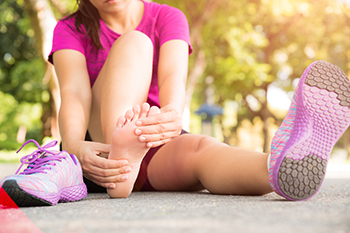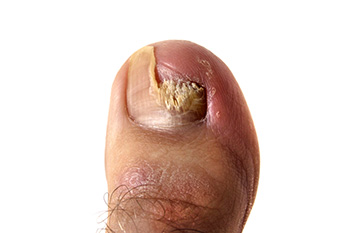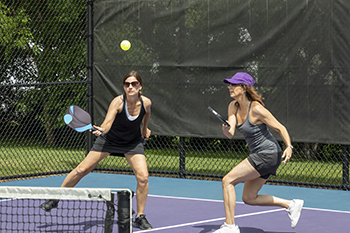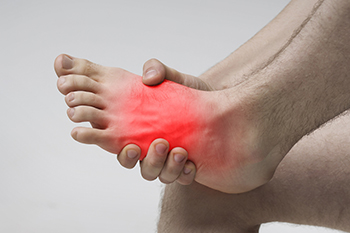Blog
Blog
Why Does My Big Toe Hurt When I Run?

Pain in the joint of the big toe, termed hallux rigidus, is a form of osteoarthritis caused by the wearing away of cartilage between the base of the big toe and the first metatarsal bone of the foot. This condition often affects runners, as the big toe takes the brunt of the continual pounding with each step. Hallux rigidus often develops in runners between the ages of 30 and 60. Some possible causes include having flat feet or overpronation, which is when the foot rolls inward 15 percent or more with each step. Overtraining, a stubbed toe, gout, a toe deformity, or genetics may also play a role in the development of hallux rigidus. Limited mobility and stiffness in the big toe joint are early symptoms of this disorder. In addition, a runner may experience pain and swelling on top of the big toe. Changing to footwear with a larger toe box and stiffer sole can help relieve the pressure on the big toe. Certain medications may also help. A podiatrist can examine the toe, determine the cause of the joint pain, and offer appropriate treatment solutions. It is suggested that you make an appointment today.
Toe pain can disrupt your daily activities. If you have any concerns, contact one of our podiatrists of Port Richmond Family Footcare. Our doctors can provide the care you need to keep you pain-free and on your feet.
What Causes Toe Pain?
Most severe toe pain is caused due to a sports injury, trauma from dropping something heavy on the toe, or bumping into something rigid. Other problems can develop over time for various reasons.
Toe pain can be caused by one or more ailments. The most common include:
- Trauma
- Sports injury
- Wearing shoes that are too tight
- Arthritis
- Gout
- Corns and calluses
- Hammertoe
- Bunions
- Blisters
- Ingrown toenails
- Sprains
- Fractures (broken bones)
- Dislocations
When to See a Podiatrist
- Severe pain
- Persistent pain that lasts more than a week
- Signs of infection
- Continued swelling
- Pain that prevents walking
Diagnosis
In many cases the cause of toe pain is obvious, but in others, a podiatrist may want to use more advanced methods to determine the problem. These can range from simple visual inspections and sensation tests to X-rays and MRI scans. Prior medical history, family medical history, and any recent physical traumatic events will all be taken into consideration for a proper diagnosis.
Treatment
Treatments for toe pain and injuries vary and may include shoe inserts, padding, taping, medicines, injections, and in some cases, surgery. If you believe that you have broken a toe, please see a podiatrist as soon as possible.
If you have any questions please feel free to contact our office located in Lumberton, NJ, . We offer the newest diagnostic tools and technology to treat your foot and ankle needs.
Top Causes of Ankle Pain After Working Out

If your ankles hurt after completing an aerobic workout, it may be a sign that should not be ignored. The main causes of ankle pain after working out include ill-fitting shoes, an Achilles tendon problem, arthritis, and tarsal tunnel syndrome. It is important to wear shoes that offer ample cushioning and arch support and that you wear the right type of shoe for the activity you are doing. Achilles tendonitis is one of the most common causes of ankle pain because it is prone to overuse. This causes tears in the tissue, which results in pain and inflammation. Osteoarthritis is caused by wear and tear on joints as you age. Rheumatoid arthritis is an autoimmune disease that attacks the tissues in your joints. Tarsal tunnel pain can be caused by compression of a nerve in a portion of the ankle joint. Any of these conditions can be diagnosed by a podiatrist who will offer the appropriate treatment options. It is suggested that you consult a podiatrist if you feel ankle pain after working out.
Ankle pain can be caused by a number of problems and may be potentially serious. If you have ankle pain, consult with one of our podiatrists from Port Richmond Family Footcare. Our doctors will assess your condition and provide you with quality foot and ankle treatment.
Ankle pain is any condition that causes pain in the ankle. Due to the fact that the ankle consists of tendons, muscles, bones, and ligaments, ankle pain can come from a number of different conditions.
Causes
The most common causes of ankle pain include:
- Types of arthritis (rheumatoid, osteoarthritis, and gout)
- Ankle sprains
- Broken ankles
- Achilles tendinitis
- Achilles tendon rupture
- Stress fractures
- Bursitis
- Tarsal tunnel syndrome
- Plantar fasciitis
Symptoms
Symptoms of ankle injury vary based upon the condition. Pain may include general pain and discomfort, swelling, aching, redness, bruising, burning or stabbing sensations, and/or loss of sensation.
Diagnosis
Due to the wide variety of potential causes of ankle pain, podiatrists will utilize a number of different methods to properly diagnose ankle pain. This can include asking for personal and family medical histories and of any recent injuries. Further diagnosis may include sensation tests, a physical examination, and potentially x-rays or other imaging tests.
Treatment
Just as the range of causes varies widely, so do treatments. Some more common treatments are rest, ice packs, keeping pressure off the foot, orthotics and braces, medication for inflammation and pain, and surgery.
If you have any questions, please feel free to contact our office located in Lumberton, NJ, . We offer the newest diagnostic and treatment technologies for all your foot care needs.
Toenail Fungus Can Cause Nail Damage

Toenail fungus can be unsightly. People who are afflicted with this condition are often embarrassed and may hide their feet. It is caused by a fungus that can penetrate the nail bed. Common symptoms can begin with noticing a white spot under the nail, and the nail may progress to becoming thick and brittle. If left untreated, the nail may fall off, and a new nail will grow, often with the same fungus. The fungus that causes this foot condition lives and thrives in warm and moist environments. These can include shower room floors, public swimming pools, and locker rooms. It is considered to be contagious, and its spread may be controlled by wearing appropriate footwear, such as water shoes or flip-flops. The majority of toenail fungus is treatable, and if you have this condition, it is suggested that you confer with a podiatrist who can offer correct treatment options, which may include prescribed medicine.
If left untreated, toenail fungus may spread to other toenails, skin, or even fingernails. If you suspect you have toenail fungus it is important to seek treatment right away. For more information about treatment, contact one of our podiatrists of Port Richmond Family Footcare. Our doctors can provide the care you need to keep you pain-free and on your feet.
Symptoms
- Warped or oddly shaped nails
- Yellowish nails
- Loose/separated nail
- Buildup of bits and pieces of nail fragments under the nail
- Brittle, broken, thickened nail
Treatment
If self-care strategies and over-the-counter medications does not help your fungus, your podiatrist may give you a prescription drug instead. Even if you find relief from your toenail fungus symptoms, you may experience a repeat infection in the future.
Prevention
In order to prevent getting toenail fungus in the future, you should always make sure to wash your feet with soap and water. After washing, it is important to dry your feet thoroughly especially in between the toes. When trimming your toenails, be sure to trim straight across instead of in a rounded shape. It is crucial not to cover up discolored nails with nail polish because that will prevent your nail from being able to “breathe”.
In some cases, surgical procedure may be needed to remove the toenail fungus. Consult with your podiatrist about the best treatment options for your case of toenail fungus.
If you have any questions, please feel free to contact our office located in Lumberton, NJ, . We offer the newest diagnostic and treatment technologies for all your foot care needs.
Pickleball and Plantar Fasciitis

Many people who play pickleball love to win. They may work hard at perfecting their sport and unfortunately, their feet may pay the price. The heel of the foot is commonly affected in pickleball players, which may be indicative of plantar fasciitis or a heel spur. The plantar fascia is a band of tissue that connects the heel to the toes and is found on the bottom of the foot. The plantar fascia may become torn and inflamed from consistently pushing off on the ball of the foot resulting in inflammation. Pickleball is a high-impact sport, and plantar fasciitis is often seen in pickleball players. It can be beneficial to wear shoes that fit correctly and to ensure there is adequate cushioning in the heel area. Additionally, players may choose to wear custom-made orthotics, which may be effective in reducing heel pain. If you have tried these simple measures and still have foot pain, it is suggested that you consult with a podiatrist who can determine the exact cause and offer you various prevention techniques.
Plantar fasciitis can be very painful and inconvenient. If you are experiencing heel pain or symptoms of plantar fasciitis, contact one of our podiatrists from Port Richmond Family Footcare. Our doctors can provide the care you need to keep you pain-free and on your feet.
What Is Plantar Fasciitis?
Plantar fasciitis is the inflammation of the thick band of tissue that runs along the bottom of your foot, known as the plantar fascia, and causes mild to severe heel pain.
What Causes Plantar Fasciitis?
- Excessive running
- Non-supportive shoes
- Overpronation
- Repeated stretching and tearing of the plantar fascia
How Can It Be Treated?
- Conservative measures – anti-inflammatories, ice packs, stretching exercises, physical therapy, orthotic devices
- Shockwave therapy – sound waves are sent to the affected area to facilitate healing and are usually used for chronic cases of plantar fasciitis
- Surgery – usually only used as a last resort when all else fails. The plantar fascia can be surgically detached from the heel
While very treatable, plantar fasciitis is definitely not something that should be ignored. Especially in severe cases, speaking to your doctor right away is highly recommended to avoid complications and severe heel pain. Your podiatrist can work with you to provide the appropriate treatment options tailored to your condition.
If you have any questions please feel free to contact our office located in Lumberton, NJ, . We offer the newest diagnostic and treatment technologies for all your foot and ankle needs.
Common Causes of Foot Pain

With 26 bones in the feet, accompanied by many tendons, ligaments, muscles, and joints, foot pain is often a fact of life at some time or another. Foot pain can make conducting simple daily activities difficult as well as interfere with sleep. Paying attention to persistent foot pain and getting treatment for it is suggested by seeing a podiatrist. Many treatment options are available, depending on the cause. Pain in the joints of the feet, commonly in those between the toes and metatarsals, is often caused by arthritis or nerve damage. It also may be a side effect of bone deformities, such as bunions and hammertoes. This may develop into metatarsalgia or pain in the ball of the foot. Stress fractures in the long bones of the foot are generally caused by overuse, such as long-distance running. Damage to the tendons and muscles of the foot, along with overuse and non-supportive footwear, can also cause foot pain. If you are experiencing persistent or worsening pain in your feet, it is suggested that you consult a podiatrist for a full diagnosis, followed by appropriate treatment options.
Foot Pain
Foot pain can be extremely painful and debilitating. If you have a foot pain, consult with one of our podiatrists from Port Richmond Family Footcare. Our doctors will assess your condition and provide you with quality foot and ankle treatment.
Causes
Foot pain is a very broad condition that could be caused by one or more ailments. The most common include:
- Bunions
- Hammertoes
- Plantar Fasciitis
- Bone Spurs
- Corns
- Tarsal Tunnel Syndrome
- Ingrown Toenails
- Arthritis (such as Gout, Rheumatoid, and Osteoarthritis)
- Flat Feet
- Injury (from stress fractures, broken toe, foot, ankle, Achilles tendon ruptures, and sprains)
- And more
Diagnosis
To figure out the cause of foot pain, podiatrists utilize several different methods. This can range from simple visual inspections and sensation tests to X-rays and MRI scans. Prior medical history, family medical history, and any recent physical traumatic events will all be taken into consideration for a proper diagnosis.
Treatment
Treatment depends upon the cause of the foot pain. Whether it is resting, staying off the foot, or having surgery; podiatrists have a number of treatment options available for foot pain.
If you have any questions, please feel free to contact our office located in Lumberton, NJ, . We offer the newest diagnostic and treatment technologies for all your foot care needs.
Wounds That Don't Heal Need to Be Checked
Cracked Heel Infections

If you are someone that is prone to cracked heels, then you ought to be especially aware of the possibility of developing an infection because of this condition. Cracked heels occur when the skin covering the heel becomes severely dehydrated and fissures begin to form on the skin. As a result of these fissures, the skin might even start to bleed. Infections are an important risk to be aware of if you have cracked heels. Specifically, if an individual removes skin on the heels through a process known as debridement, an infection might occur. For example, if too much skin is removed with a razor, then the individual might be setting themselves up for a nasty infection. If you have cracked heels, it is suggested that you see a podiatrist promptly. This medical professional will be able to help you treat your condition and answer any questions you might have.
If the skin on your feet starts to crack, you may want to see a podiatrist to find treatment. If you have any concerns, contact one of our podiatrists from Port Richmond Family Footcare. Our doctors can provide the care you need to keep you pain-free and on your feet.
Cracked Heels
It is important to moisturize your cracked heels in order to prevent pain, bleeding, and infection. The reason cracked heels form is because the skin on the foot is too dry to support the immense pressure placed on them. When the foot expands, the dry skin on the foot begins to split.
Ways to Help Heal Them
- Invest in a good foot cream
- Try Using Petroleum Jelly
- Ease up on Soaps
- Drink Plenty of Water
Ways to Prevent Cracked Heels
- Moisturize After Showering
- Skip a Shower
- Keep Shower Water Lukewarm
- Don’t Scrub Your Feet
If you are unsure how to proceed in treating cracked heels, seek guidance from a podiatrist. Your doctor will help you with any questions or information you may need.
If you have any questions, please feel free to contact our office located in Lumberton, NJ, . We offer the newest diagnostic and treatment technologies for all your foot care needs.
Similarities Between Ankle Sprains and Strains

An injury to the ankle can severely impact completing everyday activities. An ankle sprain is common to incur and may be similar to an ankle strain. The symptoms for both ailments can consist of pain, swelling, bruising, and difficulty walking. Treatment can begin with frequently elevating the feet and wrapping the affected foot with a compression bandage. This is generally effective in providing the necessary stability as the healing process occurs. Existing swelling can be managed when heat is avoided, such as hot baths or heat packs. There are various reasons why ankle sprains and strains occur including improperly stretching before and after exercising, or from stepping off a curb unexpectedly and twisting the ankle. It is important to obtain a proper diagnosis which typically consists of having an X-ray taken. If you have injured your ankle, please contact a podiatrist who can help you with the correct type of treatment.
Ankle sprains are common but need immediate attention. If you need your feet checked, contact one of our podiatrists from Port Richmond Family Footcare. Our doctors can provide the care you need to keep you pain-free and on your feet.
How Does an Ankle Sprain Occur?
Ankle sprains take place when the ligaments in your ankle are torn or stretched beyond their limits. There are multiple ways that the ankle can become injured, including twisting or rolling over onto your ankle, putting undue stress on it, or causing trauma to the ankle itself.
What Are the Symptoms?
- Mild to moderate bruising
- Limited mobility
- Swelling
- Discoloration of the skin (depending on severity)
Preventing a Sprain
- Wearing appropriate shoes for the occasion
- Stretching before exercises and sports
- Knowing your limits
Treatment of a Sprain
Treatment of a sprain depends on the severity. Many times, people are told to rest and remain off their feet completely, while others are given an air cast. If the sprain is very severe, surgery may be required.
If you have suffered an ankle sprain previously, you may want to consider additional support such as a brace and regular exercises to strengthen the ankle.
If you have any questions please feel free to contact our office located in Lumberton, NJ, . We offer the newest diagnostic and treatment technologies for all your foot and ankle needs.
Ways to Prevent Getting Foot Blisters

Blisters are fluid-filled bubbles that can form on the toes, soles, or heels of your feet when they rub against the inside of a firm or tight-fitting shoe. The blister itself is nature’s way of protecting the skin from this friction by separating the layers from each other. Blisters frequently form when you walk too far in shoes that do not fit properly or by not wearing socks. Most blisters will heal on their own after a few days of resting the site and avoiding the condition that caused them. Covering the blister with a protective bandage can also help. It is not recommended to pop a blister, which may invite infection. Signs of infection include pus, hot or painful skin around the blister, and red streaks around it. Another sign of infection is when the fluid that fills a blister is bloody or changes color. If you notice any of these symptoms, the time has come to visit a podiatrist who can properly cleanse the site and afford safe treatment options.
Blisters may appear as a single bubble or in a cluster. They can cause a lot of pain and may be filled with pus, blood, or watery serum. If your feet are hurting, contact one of our podiatrists of Port Richmond Family Footcare. Our doctors can provide the care you need to keep you pain-free and on your feet.
Foot Blisters
Foot blisters are often the result of friction. This happens due to the constant rubbing from shoes, which can lead to pain.
What Are Foot Blisters?
A foot blister is a small fluid-filled pocket that forms on the upper-most layer of the skin. Blisters are filled with clear fluid and can lead to blood drainage or pus if the area becomes infected.
Symptoms
(Blister symptoms may vary depending on what is causing them)
- Bubble of skin filled with fluid
- Redness
- Moderate to severe pain
- Itching
Prevention & Treatment
In order to prevent blisters, you should be sure to wear comfortable shoes with socks that cushion your feet and absorb sweat. Breaking a blister open may increase your chances of developing an infection. However, if your blister breaks, you should wash the area with soap and water immediately and then apply a bandage to the affected area. If your blisters cause severe pain it is important that you call your podiatrist right away.
If you have any questions, please feel free to contact our office located in Lumberton, NJ, . We offer the newest diagnostic and treatment technologies for all your foot care needs.
Bacteria Can Cause Foot Odor

The feet have a total of 250,000 sweat glands. This vast collection can produce about a cup of sweat each day, more per square inch than any other body part. The feet contain eccrine sweat glands, which are designed to cool down the body. These consist mostly of salt and water and do not produce foot odor. Bacteria, which thrives in moist, warm environments such as sweaty feet enclosed in socks and shoes, does produce foul odors. Many types of bacteria live on the feet and interact with the sweat produced. Through a complex process involving the bacteria, the sweat glands, and the byproducts of those glands, foot odor is produced. The type of odor depends on which type of bacteria is present and thriving. Fortunately, there are a number of remedies and lifestyle changes available that can reduce the problem of extreme foot odor. For more information on how to handle this annoying problem, please consult a podiatrist.
Everyday foot care is very important to prevent infection and other foot ailments. If you need your feet checked, contact one of our podiatrists from Port Richmond Family Footcare. Our doctors can provide the care you need to keep you pain-free and on your feet.
Everyday Foot Care
Often, people take care of their bodies, face and hair more so than they do for their feet. But the feet are a very important aspect of our bodies, and one that we should pay more attention to. Without our feet, we would not be able to perform most daily tasks.
It is best to check your feet regularly to make sure there are no new bruises or cuts that you may not have noticed before. For dry feet, moisturizer can easily be a remedy and can be applied as often as necessary to the affected areas. Wearing shoes that fit well can also help you maintain good foot health, as well as making it easier to walk and do daily activities without the stress or pain of ill-fitting shoes, high heels, or even flip flops. Wearing clean socks with closed shoes is important to ensure that sweat and bacteria do not accumulate within the shoe. Clean socks help to prevent Athlete’s foot, fungi problems, bad odors, and can absorb sweat.
If you have any questions please feel free to contact our office located in Lumberton, NJ, . We offer the newest diagnostic and treatment technologies for all your foot and ankle needs.





